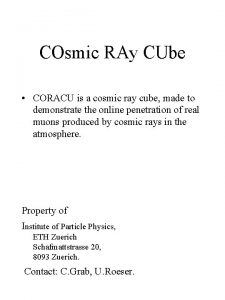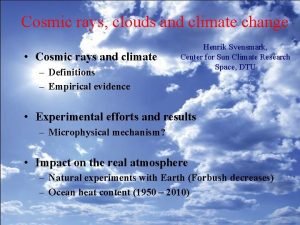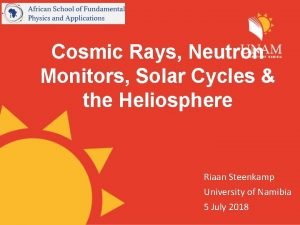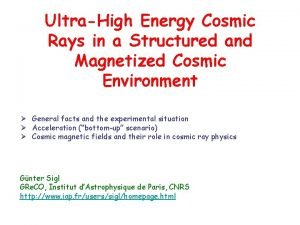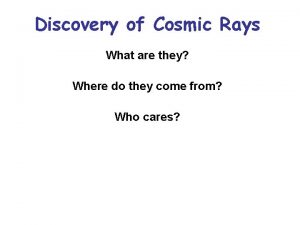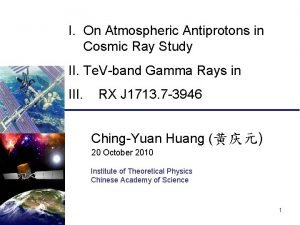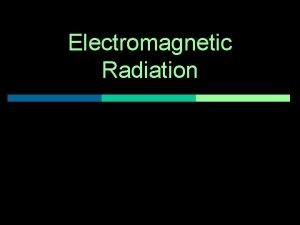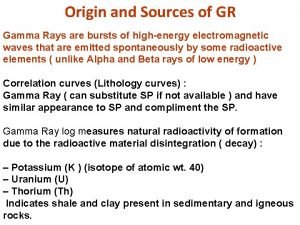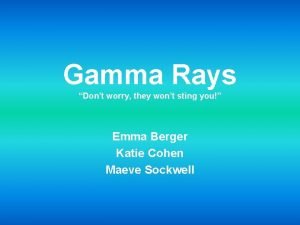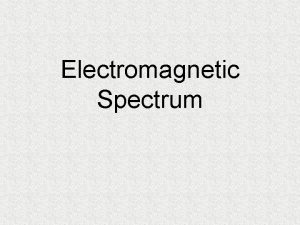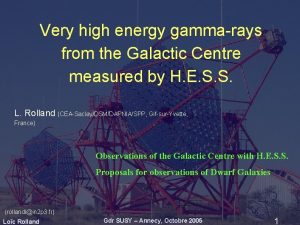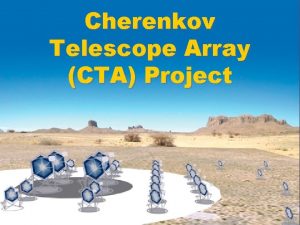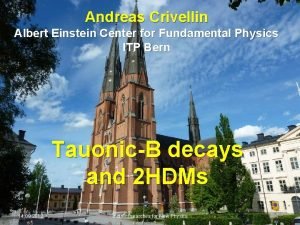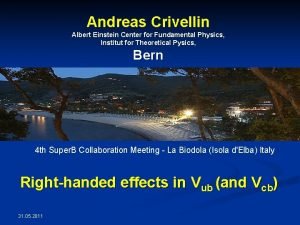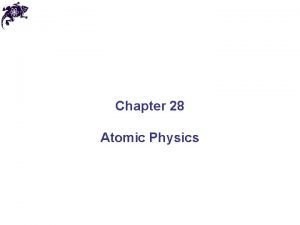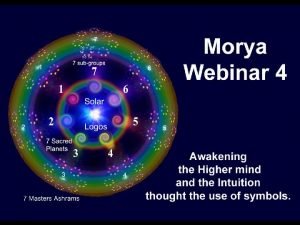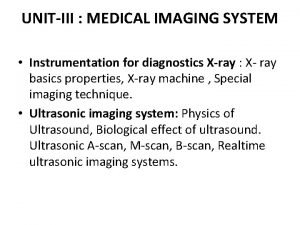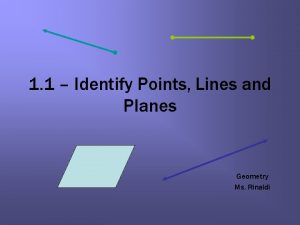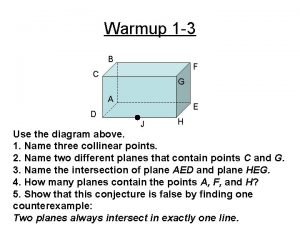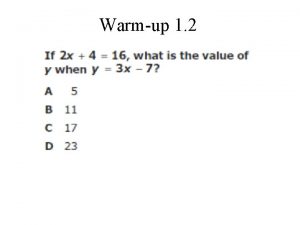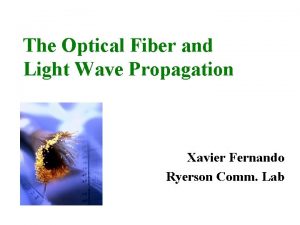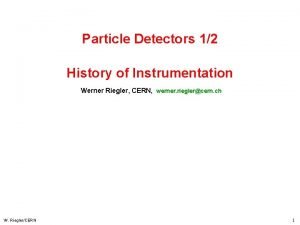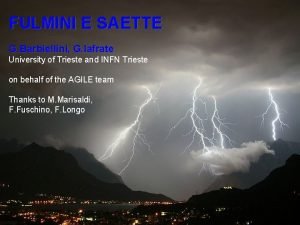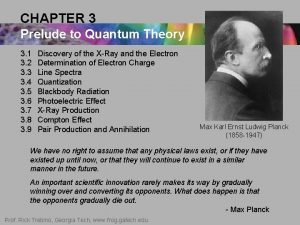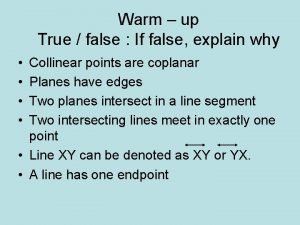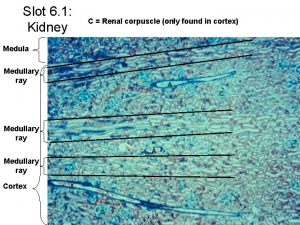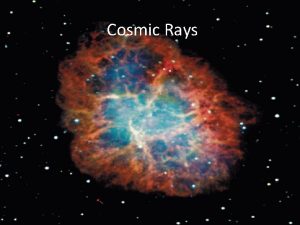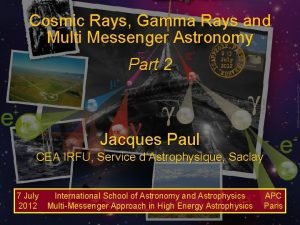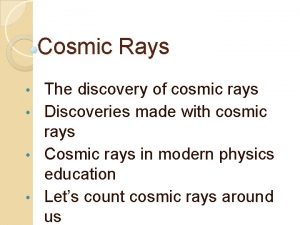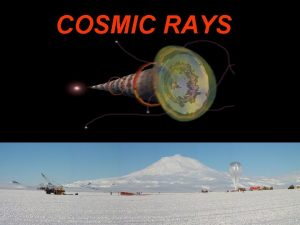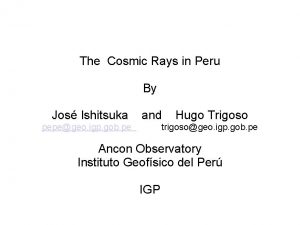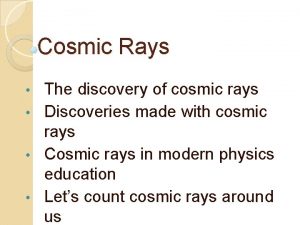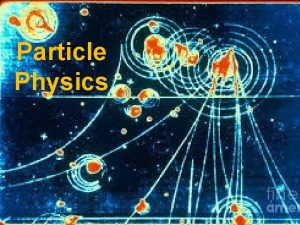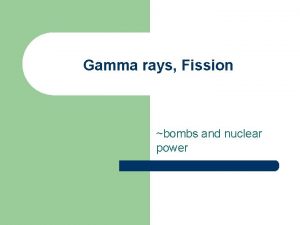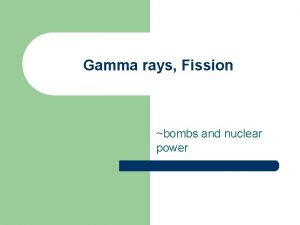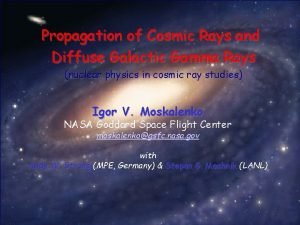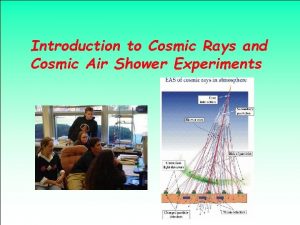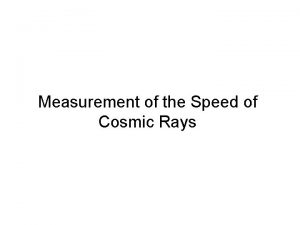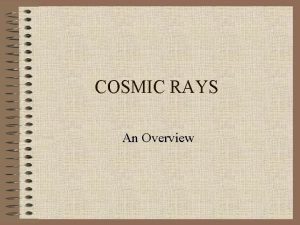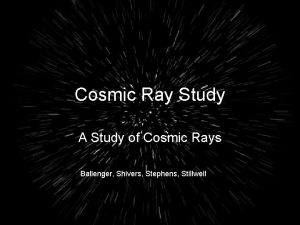Fundamental Physics with VHE Cosmic Gamma Rays DISCRETE




























































- Slides: 60

Fundamental Physics with VHE Cosmic Gamma Rays DISCRETE’ 08, Valencia 16/Dec. /2008 Manel Martinez

Outline: 0 - Introduction 1 - Cherenkov Telescopes 2 - Dark Matter 3 - Speed of light invariance 4 - Outlook

0 - Introduction

VHE Cosmic Gamma rays: highest energy electromagnetic radiation from our Universe Presently: Highest energy messengers detectable from our universe which: - Are stable particles => cosmological distances - Interact enough to be “easily” detected => modest and simple detectors - Are not deflected by cosmic magnetic fields => allow to pinpoint and identify the source with high precision

VHE Cosmic Gamma rays: highest energy electromagnetic radiation from our Universe => Highest energy wide-open window for the observation of our universe VHE GAMMA-RAY ASTRONOMY

Origen Source Studies Propagation Studies

1) Study the source: production mechanisms VHE gamma rays are produced in the most energetic and violent phenomena in the universe: A ) COSMIC ACCELERATORS - Hadron accelerators: p X -> gamma hadronic acceleration p+ (>>Te. V) matter 0 - + (Te. V)

leptonic acceleration Synchrotron e- (Te. V) (e. V-ke. V) B (e. V) (Te. V) Inverse Compton log(energy density) - Electron accelerators: synchrotron: e B -> e gamma + inverse Compton: e gamma -> gamma e Sy IC e. V ke. V Me. V Ge. V Te. V log(E)

B ) HEAVY PARTICLE ANNIHILATION OR DECAY Through the annihilation or decay of very massive or energetic objects: dark matter, very massive particles at unification scales, relics of universe phase transitions, primordial black holes, … => Tool to search for new, massive, particles and objects.

2) Study the propagation in the cosmic medium VHE gamma rays are, so far, the most energetic messengers reaching us through a determinable path: explore the structure of intergalactic medium: - at long distances: produced in sources at cosmological distances from us - at the shortest distances: they explore space-time at the highest energies => they may allow us to address important questions in fundamental physics and cosmology

1 - Cherenkov Telescopes

Observation Technique Gammaray Particle shower ~ 10 km Ch er en ko vl ig ht ~ 1 o ~ 120 m Detection of Te. V gamma rays using Cherenkov telescopes

Image intensity Shower energy Image orientation Shower direction Image shape Primary particle

Systems of Cherenkov telescopes Better bkgd reduction Better angular resolution Better energy resolution

MILAGRO VHE Experimental World MAGIC STACEE TIBET ARRAY ARGO-YBJ MILAGRO STACEE CACTUS TACTIC PACT GRAPES TACTIC HESS CANGAROO OG 1 TIBET

• Very special moment in VHE Cosmic gamma-ray observation: real revolution in consolidation of Cherenkov telescopes as astronomical instruments => transition from “HE experiments” to “telescopic installations” --> exploding interest in the astronomical community… ! • Big observational step in the last few years: - quantitative ( x 10 number of detected sources) - qualitative (extremely high quality => unprecedented detailed studies). => DOWN OF A GOLDEN AGE FOR CHERENKOV TELESCOPES !

Over 70 sources detected already (and increasing steadily. . . ) : W. Hofmann - Texas Symposium 2006

The VHE g-ray Physics Program SNRs Origin of Cosmic Rays Pulsars Galactic Binary systems Extragalactic Speed of light invariance Cold Dark Matter Cosmological -Ray Horizon OG 1 AGNs GRBs

2 - Dark Matter

• Dark Matter annihilates producing gammas as secondary particles. • Expected gamma flux proportional to (r. DM) 2 x D-2 x s => Most promising targets: - Galactic Center, - Dwarf Spheroidal Satellites (large M/L ratio), - Subhalos, - Microhalos, - Intermediate Mass Black Holes (IMBH), - Local Group Galaxies, - Globular Clusters.

Galactic Center syst. error Point-like core SGR A Extended tail Similar to NFW profile -> Consistent with SGR A* to 6’’ and slightly extended. -> No significant variability from year to minute scales (in ~40 h obs. time distributed over 2 years)

Dark matter annihilation ? Preliminary proposed based on early H. E. S. S. data 20 Te. V Neutralino 20 Te. V KK particle J. Ripken ICRC 2005 proposed before H. E. S. S. data

Gamma ray spectrum Unbroken power law, index 2. 3 Preliminary Good agreement between HESS and MAGIC (large zenith angle observation). ÞVery unlikely to be dark matter. ÞPresence of a strong gamma-ray source outshines any possible DM signal

The Galactic Centre Ridge HESS Galactic Centre gammaray count map Same map after subtraction of two dominant point sources => Clear correlation with giant molecular clouds traced by their CS emission



• So far, efforts to detect DM annihilation with VHE gammas have been unsuccessful but It turns out that VHE gamma-ray astronomy provides probably the best tool to try to unveil the nature of DM: - LHC -> may find candidates (SUSY, extra-dimensions, . . . ) but cannot prove that they are the observed Dark Matter - Direct searches (nuclear recoil) -> may recognize local halo WIMPs but cannot prove the nature and composition of Dark Matter on the sky. - Indirect searches: * Charged particles -> may detect excesses but not map them into the gravitationally identified density profiles. * Neutrino telescopes -> may need many KM 3 to reach the sensitivity attainable to VHE gamma ray installations. * Gamma satellites -> may have too limited lever arm to pinpoint DM spectral features.

• Note 1: Direct Searches and Indirect Searches look at different things: - Direct searches: WIMP-hadron interaction -> interaction of Dark Matter with ordinary matter -> lose constraints -> impact on barionic compression. - Indirect searches: WIMP-WIMP annihilation -> same process causing relic abundance -> cosmological constraints -> impact on fundamental cosmology • Note 2: LHC (and ILC) reach limited to neutralino masses of <~300 Ge. V. Beyond that only ground based instruments will be able to provide additional constraints on SUSY parameter

-> the role of VHE gamma-ray astronomy for Dark Matter studies, even beyond the discovery, is UNIQUE: ”Gamma-ray observations provide the only avenue for measuring the dark matter halo profiles and illuminating the role of dark matter in structure formation”. AGIS white book

• In addition, in the coming next few years: - LHC will have crutial information on particle candidates - Fermi (GLAST) may have found a plethora of “dark sources” already - Astronomical surveys (SDSS, Pan. STARRs, DES, . . . ) will have identified a pretty large number of (nearby) objects with large mass/light ratio. - Improved calculations/simulations will allow more precise predictions.

Contribution of Internal Bremstrahlung T. Bringmann, L. Bergstrom, J. Edsjo 2007



Sommerfeld Enhancement for slow WIMPS (non-tidaly disrupted clumps) M. Lattanzi and J. Silk 2008

Or even: - The results of DAMA, PAMELA, ATIC, etc. . . might have been confirmed as DM signals. => there are very good prospects for VHE gamma ray astronomy playing a key role for the understanding of the nature, properties and distribution of Dark Matter in the next coming years.

3 - Speed of light invariance

• Space-time at large distances is “smooth” but, if Gravity is a quantum theory, at very short distances it might show a very complex ( “foamy” ) structure due to Quantum fluctuations. • A consequence of these fluctuations is the fact that the speed of light in vacuum may become energy dependent. • The energy scale at which gravity is expected to behave as a quantum theory is the Planck Mass EQG = O(MP )= O(1019) Ge. V

• From a purely phenomenological point of view, the effect can be studied with a perturbative expansion. The arrival delay of -rays emitted simultaneously from a distant source should be proportional to the path L to the source and a the difference of the power n of their energies: • The expected delay is very small and to make it measurable one needs to observe very high energy -rays coming from sources at cosmological distances which emit gammas with a sharp time structure


Results before MAGIC and HESS: Gamma rays of high energies (E) Cosmological distances (D) Short duration transients in time profiles Pulsars, E up to 2 Ge. V, D about 10 kpc, (Kaaret, 1999) < ms AGNs, E up to 10 Te. V, D about 100 s Mpc (Biller, et al, 1999) < minutes 35 GRBs, E up to Me. V, D beyond 7000 Mpc (Ellis, et al, 2005) < 100 ms A. Sakharov 2007

MAGIC observation of Mkn 501 flare in 2005 (z=0. 034)

Astrophys. J. 669, 862 (2007)

MAGIC Results (ECF Method): Quadratic Linear 95% CL Phys. Lett B 668, 253 (2008)

• Caveat: how to disentangle propagation delays from source-intrinsic delays ? . a) observe sources at different redshifts and check delay proportional to distance. b) use geometrical time stamps (pulsars).

a) sources at different redshifts…

HESS observation of PKS 2155 flare in 2006 (z=0. 116) Benbow 1221 HESS 28 th July 2006 Paneque Crab Flux 1098

200 -800 Ge. V >800 Ge. V - No visible delay - MQG 1 > 0. 6 x 1018 Ge. V - Does not contradict MAGIC

b) geometrical time stamps…

EGRET Pulsars

2007 -2008 MAGIC detection of the Crab Pulsar Science 322 (2008) 1221 Detailed analysis ongoing.

What next ? . • GRBs: (try to catch them at VHE) - Good timing, very large distance, low energies (-> linear term) - Better statistics are expected with GLAST. - A MAGIC detection around 100 Ge. V would probably yield to very good sensitivity to energy-dependent time delays. • AGNs: (wait actively for next flare) - Bad timing, large distances, high energies (-> quadratic term) - Distance can improve with better sensitivity instruments, but paying the price of lower energies due to EBL. Timing can improve also with sensitivity. • Pulsars: (try to observe them at VHE) - Very good timing, very short distance, low energies (-> linear term) - With better instruments the time resolution will improve and the detected energy might still increase a bit. - If GLAST and MAGIC pulse shapes are similar, a combined analysis may give competitive limits.

4 - Outlook

Satellites Fermi (GLAST) • Major HE gamma-ray instrument. • Thousands of new HE sources expected. • LAT: coverage from 20 – 300 Ge. V. • Launched in May 2008. • Many discoveries and new results coming. . .

Cherenkov Telescopes - 1 • • MAGIC-II New, improved 17 m telescope. Faster FADCs (up to 4 Gsps) and a better high-QE camera. Factor 2 -3 improvement in sensitivity. First light in 2009.

Cherenkov Telescopes - 2 HESS-II • New 28 m telescope. • 2048 pixel camera. • Lower energy threshold 40 -50 Ge. V • First light in 2010

The present generation of ground instruments may detect and study around 100 sources, but a lot of physics potential still open… What next ?

C TA Possible CTA sensitivity An advanced facility for ground-based high-energy gamma ray astronomy GLAST Crab E. F(>E) [Te. V/cm 2 s] 10% Crab MAGIC few very large telescopes densely packed H. E. S. S. many medium size telescopes covering a large area many small telescopes spread in 1% Crab a very large area

C TA An advanced facility for ground-based high-energy gamma ray astronomy Aims to explore the sky in the 10 Ge. V to 100 Te. V energy range with ~10 better sensitivity and better energy and angular resolution. Builds on demonstrated technologies. Combines guaranteed science with significant discovery potential. Full sky coverage: South array ~100 M€ North array ~50 M€ Not to scale !

C TA Status and Outlook An advanced facility for ground-based high-energy gamma ray astronomy - ASPERA-Ap. PEC give full support to CTA in its roadmap. - CTA also included in the ASTRONET roadmap. - Recently included in the ESFRI updated roadmap. 2008 - 2010 -> Technical Design Report 2010 - 2012 -> Preparatory Phase (Array Prototyping) 2012 - 2017 -> Array Construction partial operation could start already in 2012 -2013

Summary: - VHE gamma astronomy may play an UNIQUE role in the understanding of Dark Matter and other Fundamental Physics issues. - VHE gamma astronomy is today in a golden age and the prospects for tomorrow and the near future are even more exciting… stay tuned !.
 Cosmic rays
Cosmic rays Svensmark
Svensmark Cosmic rays
Cosmic rays Cosmic rays
Cosmic rays Cosmic rays discoverer
Cosmic rays discoverer Cosmic rays
Cosmic rays Gamma rays uses
Gamma rays uses Geiger counter youtube
Geiger counter youtube Origin of gamma rays
Origin of gamma rays Images of gamma rays
Images of gamma rays Who discovered the gamma rays
Who discovered the gamma rays Raging martians invade venus
Raging martians invade venus Vhe
Vhe Vhe
Vhe Virus vhe
Virus vhe Albert einstein center for fundamental physics
Albert einstein center for fundamental physics Albert einstein center for fundamental physics
Albert einstein center for fundamental physics Why does it happen
Why does it happen University physics with modern physics fifteenth edition
University physics with modern physics fifteenth edition Ia examples physics
Ia examples physics Triangle that has no congruent sides
Triangle that has no congruent sides An exact position
An exact position Lobule kidney
Lobule kidney Cathode rays
Cathode rays Energy transfer
Energy transfer Louis prang color wheel
Louis prang color wheel Who invented x ray
Who invented x ray Phloem rays
Phloem rays Rays plum puddings
Rays plum puddings 7 rays
7 rays Sun's rays
Sun's rays Linear pair example
Linear pair example Properties of x rays
Properties of x rays Cross section of a tree and its parts
Cross section of a tree and its parts Macro bending losses in optical fiber
Macro bending losses in optical fiber Another word for two
Another word for two Examples of points lines and planes
Examples of points lines and planes Visual rays in perspective drawing
Visual rays in perspective drawing Opposite rays math
Opposite rays math Mode theory of circular waveguide
Mode theory of circular waveguide What are opposite rays
What are opposite rays Name 3 points
Name 3 points Lesson 1-3 segments rays parallel lines and planes
Lesson 1-3 segments rays parallel lines and planes Properties of cathode rays
Properties of cathode rays V number in optical fiber
V number in optical fiber Goldstein discovery of canal rays
Goldstein discovery of canal rays A linear pair whose vertex is f
A linear pair whose vertex is f Introduction of light reflection and refraction
Introduction of light reflection and refraction Sun's rays
Sun's rays Orange sun rays figure of speech
Orange sun rays figure of speech Who discovered x rays
Who discovered x rays X rays
X rays Protective housing x ray tube
Protective housing x ray tube A part of a line consisting of two endpoints
A part of a line consisting of two endpoints Natural rays
Natural rays N-rays
N-rays Opposite rays form a line. true false
Opposite rays form a line. true false Geometry ray definition
Geometry ray definition Medula rays
Medula rays Sensitized material in photography drawing
Sensitized material in photography drawing Tangent rays of the sun
Tangent rays of the sun
